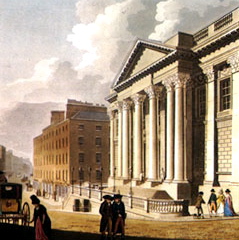Thomas Cooley (architect) facts for kids
Thomas Cooley (born 1740, died 1784) was an important architect. He was born in England but became famous for his work in Ireland. He moved to Dublin from London after winning a big competition in 1768. This competition was to design the Royal Exchange building.
Contents
Early Life and Learning to Build
Thomas Cooley was born in London. He started learning to be a carpenter in 1756. Even then, he was very interested in architecture, which is the art of designing buildings.
He worked for another architect and engineer named Robert Mylne. Cooley was a draughtsman, meaning he drew detailed plans, and also a clerk. He helped Mylne while Mylne was building the Blackfriars Bridge in London.
In 1769, Cooley won a design competition for a new Royal Exchange in Dublin. This building is now known as the City Hall. It was finished in 1779. Cooley's design showed the influence of Mylne's style, which was inspired by a type of building design called neoclassical. This style used ideas from ancient Greek and Roman buildings.
Designing Buildings in Ireland
When Thomas Cooley arrived in Ireland in 1768, he started designing many public buildings in Dublin. He used the popular neoclassical style. Cooley was part of a group of architects, including James Gandon, who were inspired by Sir William Chambers.
Cooley designed several important buildings in Dublin. These included the Royal Hibernian Marine School and a chapel. He also started work on another large public building in Dublin in 1768. Sadly, Cooley passed away at the age of 44 before he could finish it. Another famous architect, James Gandon, took over the project and completed it. This building became known as the Four Courts.
Outside of Dublin, Cooley designed country houses. One example is Caledon, built in 1779 for James Alexander. He also designed several buildings in Armagh. These include the Archbishop's Palace, which is now the town hall, and the public library.
Buildings Designed by Thomas Cooley
Here is a list of some of the buildings Thomas Cooley designed or worked on:
- St Patrick's Cathedral, 1769 – He surveyed the building.
- Headfort House, 1769–1771
- Palace Demesne, Archbishop's Palace – He helped redesign parts of it.
- Royal Hibernian Marine School, 1770–1773
- Chapel at Phoenix Park, Royal Hibernian Military School, 1771
- Public Library at 43 Abbey Street, Armagh, 1771
- Ardbraccan House, 1772–1775
- Newgate Prison, Dublin, 1773–1781
- The Royal School, Armagh, 1774
- Bishop's Palace, Killaloe, 1774
- Royal Hospital Kilmainham, 1775–1777
- The Four Courts, Inn's Quay - He designed parts of the west courtyard, 1768–1802.
- Enlargement of the Linenhall, 1784
- Lisnadill church, 1772
- Armagh gaol, 1780
His Family Life
Thomas Cooley stayed in Ireland from 1781 until he died. He had a son named William and a daughter. His wife passed away before him.


